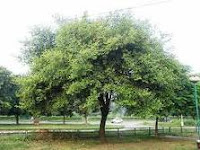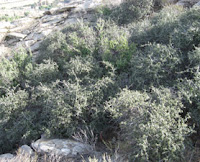AMALAKI, AMLA, INDIAN GOOSEBERRY, (EMBLICA OFFICINALIS)
 The Amalaki, Amla, or Indian gooseberry is related to the commonly known European types of gooseberry but it is not the same, nor does it have the same properties. For one thing the Indian gooseberry grows on trees while the European gooseberry grows on bushes. The Indian one has big stones in it whereas the other gooseberry has small seeds all through it. When the Western world discovered this Indian Gooseberry in recent years, with the boom in sales of dietary supplements and alternative and complementary medicines this fruit was hailed as the “new superfruit” which just goes to show how “western-centric” journalists in the West are. The Indian gooseberry was mentioned in the Rig Veda, a materia medica that was written somewhere around 3000 BC. How can they describe it as a “new” superfruit?
The Amalaki, Amla, or Indian gooseberry is related to the commonly known European types of gooseberry but it is not the same, nor does it have the same properties. For one thing the Indian gooseberry grows on trees while the European gooseberry grows on bushes. The Indian one has big stones in it whereas the other gooseberry has small seeds all through it. When the Western world discovered this Indian Gooseberry in recent years, with the boom in sales of dietary supplements and alternative and complementary medicines this fruit was hailed as the “new superfruit” which just goes to show how “western-centric” journalists in the West are. The Indian gooseberry was mentioned in the Rig Veda, a materia medica that was written somewhere around 3000 BC. How can they describe it as a “new” superfruit? |
| Amalaki Tree |
It has been used throughout the centuries as an aphrodisiac and a cure for impotence as the well told story of the sage Muni Chyawan illustrates. The sage restored his youthful sexual vigour with this fruit some time in the 7th century, so if it was good enough for him, men thought, it was good enough for them.
In Ayurvedic medicine it is used to restore a jaded appetite, and to strengthen the functions of the pancreas of diabetics and stimulate the production of insulin. It is a scared plant because of its healing properties, and it can help rejuvenate the elderly, combating inflammation caused by arthritis, and acting as a tonic in general and for those who are recovering from an illness in particular. It helps to purify the blood, and is given to people with hepatitis, as it helps the liver function normally. It is also good for the spleen and for those who suffer from gout, osteoporosis, and asthma and has been used to treat a plethora of other diseases too.
Recent trials have found that it is very beneficial in the treatment of diabetes which supports its use in traditional medicine in Asia.
 To treat asthma herbalists recommend taking 5 grams of amla fruit with honey every morning. To prevent hair loss you should eat 6 amla fruit or boil them in a cup of milk then remove the large seeds and mash to a pulp in the milk. You should then apply this paste to your hair roots and leave it on for 20 minutes before washing your hair. Drink fresh juice from the Indian gooseberry every day to purify the blood and prevent skin problems such as acne. If there is no fresh juice, then you can use 2 grams of amla powder mixed with ghee and honey and eaten.
To treat asthma herbalists recommend taking 5 grams of amla fruit with honey every morning. To prevent hair loss you should eat 6 amla fruit or boil them in a cup of milk then remove the large seeds and mash to a pulp in the milk. You should then apply this paste to your hair roots and leave it on for 20 minutes before washing your hair. Drink fresh juice from the Indian gooseberry every day to purify the blood and prevent skin problems such as acne. If there is no fresh juice, then you can use 2 grams of amla powder mixed with ghee and honey and eaten. If you have lost your appetite then you should try this remedy: - 1 part cloves, 1 part nutmeg, 1 part fresh green chilli pepper chopped finely,3 parts amla and 8 parts ginger root ground to a powder. You need to add gur or jaggery to taste and eat 2 or 3 teaspoons before each meal.
 You can make a preserve of amla by cutting the fruit into small pieces, covering them with lemon juice and rock salt and storing in an airtight glass jar in a cool dark place. This is good for indigestion. You can use the bark and leaves in a decoction for mouth ulcers. Put the bark and leaves in water and boil until the water has reduced by half; leave to cool then strain and use as a gargle for sore throats and mouth ulcers. You can also drink this hot as a tisane and it will help with any stomach problems you might have, but only take half a cup at first, with honey, to see how it reacts on you. It is a purifier, so may have a laxative effect.
You can make a preserve of amla by cutting the fruit into small pieces, covering them with lemon juice and rock salt and storing in an airtight glass jar in a cool dark place. This is good for indigestion. You can use the bark and leaves in a decoction for mouth ulcers. Put the bark and leaves in water and boil until the water has reduced by half; leave to cool then strain and use as a gargle for sore throats and mouth ulcers. You can also drink this hot as a tisane and it will help with any stomach problems you might have, but only take half a cup at first, with honey, to see how it reacts on you. It is a purifier, so may have a laxative effect. I am told that if you take 1 teaspoon of amla powder with 2 teaspoons of jaggery for a month, it will reduce the aches and pains of rheumatism.
These Indian gooseberries certainly have Taste and work as a Treat(ment) too.






















